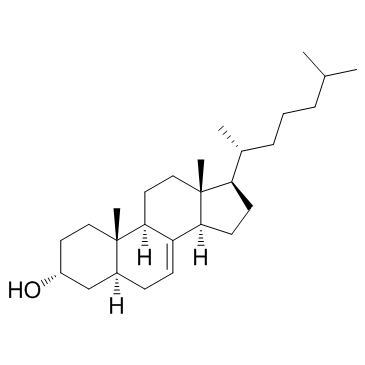Serum lipid responses to weight loss differ between overweight adults with familial hypercholesterolemia and those with familial combined hyperlipidemia.
Rocío Mateo-Gallego, Sofía Perez-Calahorra, Montserrat Cofán, Lucía Baila-Rueda, Ana Cenarro, Emilio Ros, José Puzo, Fernando Civeira
Index: J. Nutr. 144(8) , 1219-26, (2014)
Full Text: HTML
Abstract
The effect of weight loss on lipids differs among individuals, although whether it can modify the management of hereditary hyperlipidemias has not yet been explored. The objective of this study was to examine the effect of weight loss on cholesterol metabolism, assessed by circulating noncholesterol sterols, in overweight adults with familial hypercholesterolemia (FH) and familial combined hyperlipidemia (FCHL). We conducted a 6-mo weight loss intervention in untreated individuals (FH: n = 28; FCHL: n = 50) with a body mass index of >25 kg/m(2) and mean age of 46.9 ± 11.3 y, of whom 53.8% were men. A hypocaloric diet was implemented and serum lipid analyses, including noncholesterol sterols, were assessed. Global significant mean weight losses of 5.7 kg (-6.6%) and 6.6 kg (-7.6%) were achieved after 3 and 6 mo, respectively. Mean non-HDL cholesterol and triglyceride (TG) changes at 3 and 6 mo compared with baseline were -5.8% (P = 0.004) and -7.1% (P = 0.014), and -30.1% (P < 0.001) and -31.4% (P < 0.001), respectively. Among participants who lost ≥5% body weight, only significant changes in TGs and non-HDL cholesterol were observed in FCHL participants. Sterol precursors of cholesterol synthesis decreased significantly by 10.4% at 6 mo in FCHL participants, mostly because of a 23.9% lathosterol reduction. Baseline synthesis precursors were associated with TG reduction in FCHL participants (P = 0.039; R(2) = 0.20), and intestinally derived sterols were inversely associated with non-HDL cholesterol changes in FH participants (P = 0.036; R(2) = 0.21). Thus, FCHL participants had a better lipid-lowering response to weight loss than did FH participants. This response was positively associated with baseline cholesterol synthesis, which was reduced by weight loss. Our results confirm the cholesterol overproduction mechanism of FCHL and its interaction with fat mass, while also supporting the differential management of familial hyperlipidemias if obesity coexists. This trial was registered at clinicaltrials.gov as NCT01995149. © 2014 American Society for Nutrition.
Related Compounds
| Structure | Name/CAS No. | Molecular Formula | Articles |
|---|---|---|---|
 |
cholesterol
CAS:57-88-5 |
C27H46O | |
 |
Lathosterol
CAS:80-99-9 |
C27H46O |
|
Rehmannia glutinosa (Gaertn.) DC. polysaccharide ameliorates...
2015-04-22 [J. Ethnopharmacol. 164 , 229-38, (2015)] |
|
G-protein-coupled estrogen receptor 1 is anatomically positi...
2015-02-11 [J. Neurosci. 35(6) , 2384-97, (2015)] |
|
Activation of Tomato Bushy Stunt Virus RNA-Dependent RNA Pol...
2015-05-01 [J. Virol. 89(10) , 5714-23, (2015)] |
|
Itraconazole suppresses the growth of glioblastoma through i...
2014-07-01 [Autophagy 10(7) , 1241-55, (2014)] |
|
Retinal and nonocular abnormalities in Cyp27a1(-/-)Cyp46a1(-...
2014-09-01 [Am. J. Pathol. 184(9) , 2403-19, (2014)] |